Tag: Visual edit |
m (Reverted edits by Plutfuse (talk) to last revision by Fuzzo the fuzzy bee) Tag: Rollback |
||
| Line 232: | Line 232: | ||
<tabber> |
<tabber> |
||
|-|Basic Info= |
|-|Basic Info= |
||
| − | Plutfuseverse does not exist alone floating in darkness of |
+ | Plutfuseverse does not exist alone floating in darkness of multiverse; it has many friend verses around it (6.022 x 10<sup>16</sup> friends). |
Verses orbit plutfuseverse at static orbit. Some verses collide or absorbed into outer penteract, but usually, they don't do that here. But rather like verses formed inside plutfuseverse, many verses that have orbit close to plutfuseverse's penteract gets tesseract as penteract's rotational energy and dimensions flows into barriers of close-orbiting verses. Verse destruction time again, and many new objects formed from destruction is filled with radioactiveness and starts orbiting. |
Verses orbit plutfuseverse at static orbit. Some verses collide or absorbed into outer penteract, but usually, they don't do that here. But rather like verses formed inside plutfuseverse, many verses that have orbit close to plutfuseverse's penteract gets tesseract as penteract's rotational energy and dimensions flows into barriers of close-orbiting verses. Verse destruction time again, and many new objects formed from destruction is filled with radioactiveness and starts orbiting. |
||
Revision as of 01:29, 4 June 2021
This page is part of Structures Throughout Transinfinite Spaces
(this page is of course not a source for facts)
⌬ About plutfuseverse
Plutfuseverse is highly radioactive emission verse with structures like observable universe. Size is unknown, but is comparable to omniverse, at ω x 0.00188. Plutfuseverse is enveloped in 5-cube or penteract, unlike (extremely) smoller universes that are enveloped in 12D dodecahedron.
Due to insane amount of radiation emitted by nuclear fissions going on literally EVERYWHERE, almost all objects emit bright blue color and life habitability is close to zero (approx 0.01%). Temperature reaches millions of degrees everywhere, and background radiation itself is energetic enough to disassemble any atoms in periodic table.
⌬ Objects inside plutfuseverse
Stars exist in this verse, which has approximately same mechanism . However, stars' main fuel is plutonium. Unlike nuclear bombs which convert maximum 0.8% of mass through fission reaction, stars are so massive and luminous, that leftover radioactive elements go fission too. It allows fuel to be efficiently used, significantly extending stars' lifetime.
Planets, moons and atoms also exist, except that they are... a little unique. Galaxies have strange shapes too :D
⌬ Forces inside plutfuseverse
Observable universe's forces are exactly same as forces of plutfuseverse. It means bosons are same, so every other quantum mechanical stuffs. There is one exception tho: forces work in 5 different dimensions, instead of 4.
ANOTHER EXCEPTION: gravity is surprisingly weak. Even giant collection of mass like star galaxies does not much attract by gravity. Instead, electromagnetic force is major force in this universe. It acts like gravity, substituting everything gravity is doing in universe. Light speed is close to
ω x 0.00296 / second
This weirdness brings stars, planets, and everything much closer, since electromagnetic force is 1036 times stronger than gravity and its transferring speed is tremendous. Which make very cool things happen: in some little dense (not really "little dense") region, you can jump to another celestial object by literally jumping, because the objects rarely orbit each other at distance less than 2m or touch each other.
⌬ Plutonium
Unlike our universe where plutonium is extremely rare, around 47% of material inside plutfuseverse is plutonium. It is like rocks and hydrogen in here. Plutonium performs various important actions such as building the star and planets. Outside plutonium, roles of other highly radioactive elements are also very important.
⌬Objects inside plutfuseverse
Of course, I would not write about plutfuseverse THIS MUCH if it was just a void filled with thin mintradioactive metal mintgas with min-*gunshot*flash occasionally illuminating some nebula because if that was the case, plutfuseverse would be bad, unfunny verse.
⌬Asteroids
Few small (feast size to house sized) lump of radioactive elements (mostly plutonium) can spin few times per second either by collision between other objects or electromagnetic disruption from big object. Rapid spinning generates magnetic field comparable to that of earth. How it can generate such high magnetic field? It is because radioactive elements including plutonium always decays violently. And hotter the material, stronger the magnetic field.
⌬Small asteroid
That magnetic field attracts other balls of plutonium (or more commonly the molten one) and merges with it. This process may stop when ball reaches size of mouse or chair you are sitting on right now (hopefully it is not some sort of dragon skull throne or kid chair). Why stops? it is mainly because collisions slowed down ball's spin so much, that its magnetic field is no longer active.
There was once boom boom period of solar system about 4 billion years ago when asteroids collided together more and more until they formed huge bodies. Reason why this reaction rarely continues for long, is:
First: for unlucky asteroids, addition of material slowly diverts STRON9 magnetic field to its core. It often results total explosion of asteroid due to pressed plutonium going boom or slow down and stopping of asteroid growth due to weak magnetic field.
Second: Not enough minerals!! Need more vespene gas!! Spawn more overlor *gunshot sound*
⌬Large asteroid
But growth stop is not where small asteroids cease to be active! It can still contribute to some ("some" in here refers to 0.01%) lucky asteroid that did not loose its magnetic field. Hmm, what if you are asteroid do NOT wanna contribute to growth? Too bad, you are going to anyway because probability of luck granting your wish is very slim at 0.0001%.
Sure, you can merge leftover magnetic field with big body and become moon of it or be part of huge ring system that is around almost all stars of plutfuseverse, but that is kinda cheating!
⌬Planets
Large bunch of asteroids colliding together can form large bodies known as planets. (In plutfuseverse) They are mainly plutonium, usually spits volcano of vaporized radioactive gas, is SPHERE not STUPID DISK >:((, and glows deadly blue by all that ultra-energetic gamma ray from fission reactions. Trace amount of radioactive hydrogen gets inside these bodies and fuse from billion degree plasma, briefly making these planets a stars.
But soon, all hydrogen turns into iron, which turns into pure electromagnetic radiation due to photo-disintegration.
⌬Dwarf planets
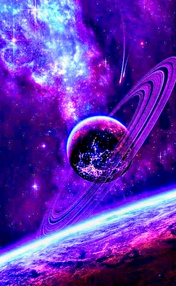
Binary system of dwarf planets.
When very large asteroids collide together, they melt from sudden fission reaction. But radioactive silicates and carbons from death of stars (I will explain stars later) blocks neutrons from fission reactions and prevents whole asteroid going boom. This way, asteroid lumps can grow more and more. At certain point, lump gains spherical shape. It has thin atmosphere of radioactive gas.
Now the dwarf planet is born. It has two types: solid and liquid.
- Solid dwarf planets: forms when planet has lots of materials outside plutonium such as silicate and carbons. Inner core reaches billions of degrees but surface is barely cool enough for plutonium to exist as solid (little below 639c' and FUN FACT: this is temperature of normal brown dwarfs). Sea of radioactive lead, aluminum, tin and other low-melting point metals flow through open cracks. Planet emits powerful blue light which even manage to come through thick sea of molten metals.
- Liquid dwarf planets: Planet has temperature so high, that it is usually hotter than melting point of silicate (1414c'). From inside, radioactive metals vaporize. Metal vapor erupts to outside, sending out blue shockwave of gamma ray. Huge islands composed of radioactive tungsten & other crystallized high-melting point radioactive metals float on radioactive sea.
(of course, all planets including dwarf planets have at least one smol asteroid, ring, or large body as a moon)
⌬Normal planets

Yup, just a planet
When few dwarf planets collide together, they completely blow up or merge to form larger dwarf planet. When few dwarf planets collide together, they jumble together to form a planet. Planets are like dwarf planets but much more violent and have thicker atmosphere. Inner cores are much hotter and these types of planets can cause second fission reaction, meaning pressure is great enough for product of plutonium or uranium fission to split once again.
Normal planets also have liquid and solid type planets.
⌬Vapor planets
Vapor planets are gas planets of plutfuseverse. These kind of planets have extremely thick atmosphere of vaporized plutonium, radioactive carbon vapor, etc. These planets look approximately like Jupiter, but hot enough to boil plutonium into vapor (with wonderful coincidence number: 3232c'). Above the immense core (much larger than "normal planet"), cloud of extremely hot radioactive material occasionally flashes with insane luminosity by fusion reactions.
Flash releases gamma ray more than planet itself does in a year. So anyone standing on surface of planet can expect to have their body to be physically destroyed by intense wave of gamma rays washing off atoms in their body. The flash generates shockwave that punches materials of planet's atmosphere to interplanetary space. Some begins to circle planet, planet's moon, and planet's star, but much of material crystallizes and rains sharp blue metal fragment over the planet.
This planet is one of worst hell someone can imagine. Radioactive needles rain from above head, body physically collapsing from rush of gamma ray, heat of nuclear reaction burns anything to crisp, and flashes of gamma rays constantly wash off every single material and drills countless holes through the body. Probably... not so great way to go.
Vapor planets have two categories: liquid core and solid core type.
- Liquid core type: Less massive vapor planets have relatively low pressure, which allows core to flow around. It is sea of molten radioactive metals of half a trillion degrees that keeps its liquid form by mass of planet greater than high mass F-type star (meaning it is extremely dense)(planet does not become star even with this mass because plutonium is not fusion fuel). This "sea" surface swirls around and generates its own magnetic field. Magnetic field is stronger than combined magnetic field of entire )-typer star of our universe, occasionally triggering fission flares. With compact material with density greater than low mass white dwarf, each flare sends insanely strong quake across the planet.
- Solid core type: Solid core types are much chonker than liquid core planets (MEGACHONKER). Their weight is comparable to that of the sun which makes them heavy enough to compress trillion degree radioactive core more and more until. Traits are exactly same as liquid core type stars.
⌬Plutonium dwarfs
Ever heard of brown dwarfs? They appeared few times at Kurzgesagt videos and in one video it got insulted with "yo mama" joke in some space video: "...and are huge disappoint for their mums..." "...but we want to talk about stars, not wannabe failed stars..." (video source: this). Even though other scientific articles don't insult brown dwarfs THAT much, but if you ask someone in the street who knows about brown dwarfs, they will probably include word "f a i l e d s t a r s" in their description about brown dwarf.
Plutonium dwarfs are like that, but definition is little different: vapor planet but can make third or more fission product. What this means is you know, plutonium splits in two upon fission, and all vapor planets can make those two atoms (first fission product) to go fission into lighter atom (second fission product). Plutonium dwarfs are more powerful than these, they produce lighter and lighter metals.
However, plutonium dwarfs are not a star; they are f a i l e d s t a r s :P. They cannot make element lighter than iron by fission reaction. Why it have to make elements below iron to be a star? it is because they are only fuseable elements. No matter how much something glows, it is not a star when it cannot fuse something lighter to heavier one.
⌬Stars
When huge radioactive gas planets pass certain mass point, they now begin to live as a star. Weight and density of gas lump compresses core hard and dense so fission reaction continues until it produces elements lighter than iron. They instantly fuse, releasing neutrons in the process. Neutron helps more fission, and fusion from new formed element go on, releasing more neutrons, ... nuclear fire begins which forms fusion core at gas lump.
Lifecycle of radioactive stars are simple. they are all divided into 7 different categories: O, B, A, F, K, G, and M. The only difference is that all spectral types are blue, just with slight whiter blue color from higher one.
⌬Type M stars

Surface of typical M star.
As the least massive star, it does not loose material into space that much. Due to lack of nebula around it and not a lot of gamma ray emmision, its surface is very easy to observe. Why materials are not loose into space easily? It is because of its density. Density immediately makes nearly any material making it out to space to fall directly on star.
The least massive kind of M stars have simple life: they live most of their lives as a smol, not very stonks star until it is close to end of its life and swell up by two or maybe three times. Core pressure only exceeds to level where hydrogen fuses into helium and disintegrated instantly.
Little more massive middle mass M stars have pressure to make some heavier isotopes of helium such as He6 or He8. Their power is too not stonks to produce heavier atoms.
High mass M stars are also not impressive since they can only produce some isotopes of helium (ex. He15) before atom disintegrates by radiation. Neutrons in isotopes can rarely decay to form lithium, beryllium and stuff but that's cheating because star is not using its own power!
⌬Type K&G stars

So byotiful stars. Isnt it.
Stars of this weight mainly produces extremely CHONK helium isotopes. They are usually He60. Of course, isotope THIS much unstable disintegrates in time much shorter than blink of an eye. But time it takes for helium isotopes to disintegrate is extended by super strong tiny electromagnetic shell formed around atom cores of isotopes.
Magnetic shell helps unstable heliums to fuse together, forming unstable carbon. Almost 40 neutrons are lose from each helium atom during reaction. Product which is carbon is little more stable than helium isotope that created it, but magnetic shell pops so carbon atom disintegrates.
Extremely energetic process like this lightens up the star to surprising level compared to M stars (K and G stars are thousands of times brighter than M stars). In the left picture, light blue stars are all M stars while four ULTRA bright spots are each (from top to bottom) K,G,K, and G.
Reaction close to efficiency of rotating black hole continues until star uses all hydrogen from fission, swell up, then outer layer pops violently while core is crushed to hard ball of plutonium that explodes completely later because of uncontrollable runaway fission. Addition to outer nebula formed by pop (is violet), there is also inner layer of nebula formed by boom (is light blue).
⌬Type B&A&F stars

This beautiful nebula is formed by single star hiding in nebula.
Unlike lower type stars, B,A, and F stars can fuse heavier element than carbon. Helium isotope is heavy enough (it is mainly superchonk isotope He290 to He339) and magnetic shell caused by electromagnetic field insanity of star is much more stonk than lower stars.
These stars' helium atoms loose two hundred neutrons at once per fusion. Product radioactive carbon (with approx 180 hadrons) is still unstable but kept by star's magnetic shell. Carbon can fuse into radioactive neon (carbon atom looses approx 100 neutrons in the process) with approx 160 hadrons. Neon looses another 100 neutrons in the fusion, ultimately producing explosive silicon.
The silicon does not go fusion by pressure of star, but it cannot go fusion because there are very few silicons formed by fusion and its lifetime runs out before another atom breaks through barrier of electromagnetic shell to fuse. Silicon atom "explodes" into countless photons and particles, giving away 100% of energy including atoms that formed it.
At the end of their life, more and more silicon atoms start to form, exploding more frequently and expanding the star. When fuel is exhausted, silicon no longer supports expanding star. Star collapses back and huge boom happens. All materials lower than iron is fused to giant soup of quarks while plutonium on the surface keeps going fission.
This some sort of quark stars have radius close to that of the ceres (stars of plutfuseverse is much more massive than universe, sooo... :D) inner layer kept by VERY HARD superheated crystal plutonium layer keeping solid state because of gravity. But fission occurs frequently, opening smol cracks. Quark matter violently erupts outward, widening the crack. Eventually, fission weakens plutonium shell so much, more crack opens until quark star explode.
⌬Type O< stars

Center of bright nebula is star
O stars in plutfuseverse is chonker than any quasi stars (1000000 or more solar mass). It is also extremely bright; there is very bright blue star at left bottom of picture. It is neither a star nor cluster of it. It is supernova, death of B, A, and F star! And the O star in the picture is newborn, even before it starts to go crazy and balloon into crazy brightness!
What makes them O star is simple: their magnetic bubble around atomic core is strong enough to sustain radioactive silicon atoms until they fuse into iron. But because helium isotopes in first place has 1904 neutrons, iron atom is MEGACHONK. Magnetic bubble around is still not gone around it, exploding some seconds after atom jumped to insane atomic number.
Ofc, fuel slowly runs out as they are all turned into exploding iron atom. Star contracts a little and fuel explosively resists to be as hard as ignorant barrier of karens. Fusion process boosts like crazy each half the star contracts. Bouncing off from runaway iron explosion,Half mass of the star turns into supermassive black hole while other half is kicked off to outside.
Formed black hole drags much of flinged off nebula to form huge accretion disk around it. Black hole forms bunch of new stars inside nebula of dead O star by collapsing formed nebula with magnetic field of accretion disk. While inside accretion disk, planets and star systems form at the edge of it while dense star cluster forms at inner accretion disk. So death of O star gives birth to small galaxy.
⌬Supernova
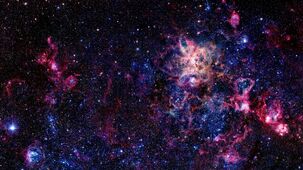
Nebula leftover from O star supernova.
Of course, supernova is end of massive star. Type K or above stars get to experience the supernova, and one special thing is supernova can form small galaxy if originating star is massive. Like supernovas in observable universe, different causes get different supernova type. Here is brief explanation what supernova type of our universe's stars are:
Type Ia (type one-a) is most common type. When white dwarf (something that is remnant of stars like our sun) passes nearby star very close so white dwarf can drain material from partner, that white dwarf is basically doomed.
Material from partner star accumulates on surface of white dwarf, increasing pressure. white dwarf gains more chonkness until it is heavier approx 1.44 times than our sun and goes boom.
Another supernova is Type II (type two) and occurs from death of very massive star's outer layer going boom while core goes moob. Chonk stars create iron from fusion then the iron kills star because it cannot be fused. fusion stops and gravity attracts gigantic mass to center, causing everything to be pulsed out again. It is type II supernova.
Like two I mentioned above, stars of plutfuseverse also go boom.
- Type ωI: It is boom of B, A, and F stars. Happens after those three types of stars explode to outward after collapse. supernova can be divided into three different category depending on product of explosion.
- Type ωIθ : F star's boom produces quark star with less pure quark matter trapped in it. What I mean by "less pure" is that quark matter includes some heavy neutrons, protons, and stuff like that floating inside it. So it is not pure because there are some other materials mixed in it.'
- Type ωIφ: is a boom of A stars which leaves remnant of high purity quark matter star. Only few HUGE hadrons (composed of hundreds, thousands or even millions of quarks) float in deep
sciensea of quark matter. - Type ωIψ: Leaves quark star containing pure quark matterTM. This quark matter is as pure as it can be.
- Type ωII: It is boom of O or higher spectral type stars. Strongest supernova flings so much material to star that it forms small galaxy.
- Type ωIIθ: Supernova produces giant black hole.
- Type ωIIφ: Supernova produces giant quark star.
- Type ωIIψ: Supernova is too powerful to produce anything for leftover
- Type ε: After K or G star fling all their outer layer to space and core is crunched to hard ball, immense runaway fission disassembles newly formed hard ball and causes this type of supernova.
- Type ζ: Type ωI supernovas gives birth to huge quark star that explodes later into type ζ supernovas. Because ωI supernovas produce different kinds of quark stars, zeta supernovas are also divided into different categories.
- Type ζθ : Because quark matter is impure, the explosion is quite weak because as soon as plutonium shell shatters a lot of quark matter is arranged into hadrons because neutrons and protons inside it acts as crystal seed for quark matter.
- Type ζφ: Much more powerful than ζθ supernova because few unstable hadrons that might act as crystal seed disintegrates before lot of quark matter could arrange themselves into hadrons.
- Type ζψ: This supernova is comparable to explosion of O stars. pure quark matter rushes outward and almost all of them are completely converted into energy.
⌬Star clusters

this one is picture of star cluster floating at very edge of its galaxy
Because stars are so close to each other (power of electromagnetic force. PRAISE THE MAGNETS!! :D), many star clusters has radius no more than 1 light years. Then how much stars are contained in one nebula in average? close to 10000. Now, imagine that all star has countless objects circling it. That's what it looks like in nebula; it is chaotic!!

The least dense one in plutfuseverse.
The density forges countless weird objects such as below:
For planets, there is a planet with ring which reflect so much light from host star that it is indistinguishable from star at far distance. Some planets are falling into star while other planets collide with each other but collision speed is too low for them to shatter; they stick together in dumbbell shape!
Stars are not exception for weirdness party. Some star has extremely strange ring system that is shaped like slight cone due to distraction dance of planet circling it. Sure, it is nice but what makes it so weird is that corn's angle focuses half of star's light to its binary star!! By that, its binary star ballooned up and is evaporating.
⌬Galaxies
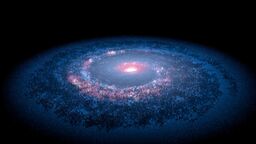
Energy & distribution map of large galaxy.
Lot of star clusters form huge galaxies with super mega hypermassive black hole (ok name is stupid but I don't know what black hole with quintillions of solar masses should be called. E hole maybe?) at center. The rotation of black hole is fast enough to generate magnetic field capable of organizing quadrillions of star clusters contained in galaxy.
I gotta explain what each color in left picture means before I write too much and cannot explain it anymore: One dot is one star cluster. Each dot has a glow that show its energy level, and darker color means star cluster is less dense and brighter color is opposite.
Then you may wonder: "what the heck there is insane glow at center of galaxy and why is there a spiral expanding out from center and only that part is super dense?"
First, the density. See the dark blue part? actually, inner dark blue part spins much faster than outer dark blue part (something dark energy believers will yell at me). Nebula and star clusters of two different speed region collides, and raises density to insane level. Now, what's wrong with center glow brighter than whole galaxy? It's because black hole eat a lot (megachonker).
Because galaxies of plutfuseverse is controlled by magnetic field, some galaxies have quite... weird shape. For example: Spiral Sb (spiral galaxy with wide straight stick at middle) can just remove the stick and outer spiral arm still orbits in same place. Another example is bubble galaxy with star clusters spread around center black hole with shape of bubble.Countless examples like conjoined bubble galaxies or ringed arm galaxy exists in plutfuseverse.
(last fun fact for galaxies: galaxy contains so much, every galaxy is usually bigger than observable universe)
⌬Galaxy webs
Many galaxies together joins together by electromagnetic force and forms space web similar to Cosmic Web of universe. This galaxy web wobbles as electromagnetic force changes direction. Of course, galaxy webs leave very empty space called void between dense part of web. But unlike boring void of our universe, huge galaxies are located inside the void that is few ten to octillion times average galaxy, all depending on the size of void.
⌬First web
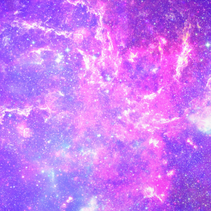
density of electromagnetic force flow of galaxy web.
The first web is composed of galaxies keeping structure with electromagnetic force. Sometimes electromagnetic bridge is disrupted by yellow I mean other galaxies or small web structure. It causes web to bend or break.
Because galaxies inside void is so large, their black hole is also megachonk. Black hole releases so much energy from accretion reaction that it creates gigantic nebula inside void. In nebula, many objects form, forms galaxy, and produced galaxy is slowly pushed away by wind of nebula coming out from black hole accretion disk.
Newborn galaxies have material to sustain itself, and between two nebula winds of giant galaxies meet, wind is compressed which concentrates even more galaxies at wind border. Many galaxies collide at here, forming 100% purity chaos regionTM.
Unlike our universe's galaxy collisions where planets, stars and stuffs rarely collide, two galaxy colliding in plutfuseverse is best at more than 1/10 objects exploding or in worst and extremely rare case, whole galaxy goes fission and fusion all at once, creating explosion indescribably powerful.
⌬Second web
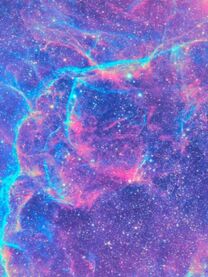
Byotiful web: E-magnetic force flow / bright dots: insanely big galaxies' black holes
The web I mentioned above does not occupy entire plutfuseverse, they arrange together at about 3.92 x 1039 light year size into second much bigger web. This web is responsible for existence of plutfuseverse center galaxy and "insanely big galaxies".
At left picture, bright dots are spots where insanely big galaxies' black holes are located. Bigger the black hole, larger the dot. Why larger dot? it is visualization of black hole's magnetic influential area. So there is more chonk galaxy in bigger dot. Galaxies THIS big does not form from reactions by huge galaxies' wind fight, but rather by process described below:
disruption of multiple second web easily creates magnetic bridge. All the smol galaxies "flow" into the region. Sure, many glaxies are destroyed during process, but they finish filling the new magnetic branch. Sometimes the magnetic bridge of web breaks, and all galaxies (try to count them and you will waste exponents of your lifetime) collect to mass center.
Galaxies collide together to form the insanely big galaxy, filling the void. Galaxies formed this way performs much bigger action than first web scale huge galaxies. The nebula from this insanely big galaxies' black hole activity creates first web! The web expands from these huge galaxies and concentrates at boundary of two or more nebula winds of insanely big galaxies.
The web's density increases as you approach center of plutfuseverse imaginary globe (sphere of plutfuseverse's influential area). This results in galaxy with center black hole little more massive than whole plutfuseverse. Actually, this black hole is leftover from big bang of plutfuseverse. Every web is formed by this black hole, and every orbiting verses orbits this black hole.
⌬Verses
Sometimes galaxies collide and release energy. This energy forms a verse seed at collision site which later blooms. By that, plutfuseverse hosts all kinds of verses, with seperate physics and properties. Of course, verses are more common at space close to second web and center point. There are all kinds of verses orbiting around central black hole. However, there are only verses smaller than hyperverse. bigger verses are found outside plutfuseverse.
Verses floating inside plutfuseverse are enveloped in various blue-violet tesseracts (such as truncated or stellated tesseracts) made from pure radiation. Sustained by very chonky penteract enveloping plutfuseverse itself, quantum tunneling osmosis happens. WAIT WAIT WAIT what is this freaking weird concept? It is actually simple:
Inner material of verse quantum tunnels (although not exactly accurate, you can thik of it as teleportation) to plutfuseverse space (quantum tunneling osmosis). If tesseract-contained verse is hyperverse, hyperverse will quantum tunnel every single xenoverses and galaxies may have left and explode with (no fitting adjective) power . Galaxies are fine, but xenoverse is not fine. As soon as xenoverse escapes from hyperverse, tesseract appears around it.
Galaxies and metaverses get out, metaverse is now enveloped in tesseract, ... this continues until hyperverse is disassembles into countless big and smol galaxies with few (about 1/10) verses that has laws of physics which don't allow tesseract to destroy the verse. They are enveloped in deadly lazar tesseract, but they are fine.
⌬Objects outside plutfuseverse
Plutfuseverse does not exist alone floating in darkness of multiverse; it has many friend verses around it (6.022 x 1016 friends).
Verses orbit plutfuseverse at static orbit. Some verses collide or absorbed into outer penteract, but usually, they don't do that here. But rather like verses formed inside plutfuseverse, many verses that have orbit close to plutfuseverse's penteract gets tesseract as penteract's rotational energy and dimensions flows into barriers of close-orbiting verses. Verse destruction time again, and many new objects formed from destruction is filled with radioactiveness and starts orbiting.
Orbits of verses are visible in thin gas and remaining light trails. invisible magnetic field of plutfuseverse expands into orbiting verses and provides insane amount of energy to its surface. The energy sometimes forms moon verse to plutfuseverse's orbiting verse, and draws a trail of matter and light like magnetic laser polygraph (don't try to make the polygraph with laser. It won't only melt your computer and patient, you may spend lot of time in jail).
I mentioned that this polygraph energy (?) forms a moon of orbiting verse of plutfuseverse. This orbiting mechanism is known as moonmoon (seriously who named it) and that moonmoon also gets connected to polygraph. Polygraph forms a moon for moonmoon, and process continues until there is gigantic fractal of moon system per verse. The polygraph energy also tries its best to form plutfuseverse-like environment inside orbiting verses.
NOTE: each verse density region has dimensional gas nebula of different density. How the freak dimensional gas managed to get inside the box? IDK ask someone who knows what a dimensional gas is.
⌬Inner imaginary globe
This globe is where plutfuseverse's galactic web reaches. Located inside innermost penteract, imaginary globe approximately connects the last tips of each galactic webs where it slowly blurs into void space inside innermost penteract.
⌬Penteracts
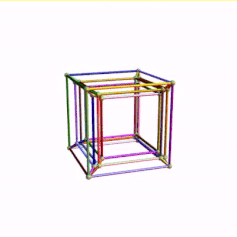
yeah. penteract. literally.
- Inner penteract has low-luminousity (each one is still brighter than 1% of plutfuseverse) shinoverses glowing same color as plutfuseverse as its corners and rotates fastest among three penteracts. It contains plutfuseverse itself and a void that hosts very few verses and galaxies floating around and being drawn into plutfuseverse. This penteract is also the least faint penteract among three.
- Middle penteract is little fainter and slower-rotating than inner one. Individual corner shinoverse is 5x more luminous than inner penteract's corner. This isn't because middle penteract's corner shinoverses are more massive, but they are less dense, meaning same mass can balloon up., raising the brightness. Between inner penteract and middle penteract, few verses and galaxies vibe around.
- Outer penteract's corner shinoverses, with density close to 10th density of middle penteract, glows with powerful light that raises visibility of outer penteract to 9x of inner penteract. Outer penteract has almost entire responsibility of tesseract formation around orbiting verses and stuff. Its rotation is slower than middle penteract, but it is much bigger adnd heavier than middle penteract. soooooooo... yeah!!!
⌬Class 1 verse density region

Fragments of exploded verse. F to pay respecctz.
At little away from outer penteract, in a nebula few tens of times side length of penteract, there are many huge verses orbited by little smaller verses. Sizes of these verses are efficiently describable with only ω ordinal-based descriptions such as ω x 0.01 because if it is described with finite values... it can't. And sure, you can describe size like ((ε0÷ω↑↑ω)+ω+(Ω-Ω)) x 0.01 but seriously, who wants to use this incredibly inefficient description method?
The most common verse sizes in class 1 verse region is ω x 0.0001 or about one-eighteenth size of plutfuseverse. At here, you see these huge verses enveloped in tesseract, slowly being disassembled. Huge galaxies and verse bubbles infinite in size floats here.
The fragments can still orbit at here at stable position, but if structure is too small (when its radius drops to finite level), penteract auto-explodes those smol objects because direct influential area of outer penteract hates finite sized objects.
⌬Class 2 verse density region

typical, spherical verse floating in class 2 verse region. Byotiful isnt it.
At nebula few hundreds of diameter of class 1 verse density region, you find verses with size little less or LOT less than ω x 10-16. Tesseracts don't form very much at here, but they still form at here due to infections of tesseracts from class 1 density region. Chonk verses in class 1 region can infect other smoller verses in class 2 region with tesseract when two verse gets too close.
Verses in class 2 region is mainly formed by verse seeds (I haven't talked about what the "verse seed" is, it is just ordinary, very simple protoverse.) born from concentration of nebula. These seeds can orbit other verse until the protoverse border breakes and everything contained inside seed explodes outward, creating verse. Formed verses decorate second density region with colorful birthday explosion and turns into plutfuseverse-like environment. F to pay respect.
⌬Class 3 verse density region

*cant speak because possessed by beauty*
Nebula density drops to average 10% of class 2 verse density region, and radius of this region expands to approx 100x class 2 verse density region radius. Although tesseract exists in class 3 region, its rarity skyrockets to almost that of person who doesn't know what E meme is. Tesseract only appears at 1 in 5000 of verses inside this region, although its size is pretty big (comparable to diameter of plutfuseverse)
At here, because there are mainly smol verses that can hardly be compared to descriptions using ω ordinal, many of orbits commonly collide with other verses' orbits. Collisions are EXTREMELY frequent, like, you can see the collision when you just look at somewhere and wait just a few min.
The reason why collision is so frequent is this: imagine Touhou (if you don't know what it is, just think about other bullet hell games) on stage 6 lunatic difficulty and all bullets (verses) draw the path of VERY slow moving laser that vanish after some time (verse polygraph). now your player can only move in none-changing circular path. How long do you think you will survive?
It's 0.1 second in real life (I know this because I tried), but extend it few trillion times and you get hundreds of billions of second which is just few hundred years. How short and destructive right? :c
The protoverse cannot draw much nebula to it before it explodes, so many protoverses don't even give birth to a verse, they just explode to form more nebula and few more protoverses. Also this density region is responsible for sustaining of shinoverse corners of outer penteract by feeding gas to it. It is good for orbiting verses when penteract disappears, but at same time disappearance is not good because with even one penteract missing explodes whole plutfuseverse.
⌬Individual physics region
Here, verses that were formed by tesseract's verse disassembling processTM. Nebula density drops to 1/10 (at innermost part) to 1/107 (at outermost part) and verses can affect regions around it with their individual laws of physics. For example, if our universe was located in individual physics region, well, of course it will get hit by galaxies and verses constantly. Aside from universe being radioactive hell, it will apply electromagnetic force and strong & weak nuclear force to region around it.
Sound weird huh? Well, it IS weird. Often enough, physics act explosively between different universes, which sometimes separates universe or galaxy in two different physics region. The border of separation is clearly visible. Why visible? because explosive reaction between two physic completely converts that region into pure beauty of explosion.
⌬Outer imaginary globe
This globe is border of plutfuseverse's influential area. It is currently expanding as electromagnetic attraction of plutfuseverse is exploding to outward. However, very few verses orbit plutfuseverse between individual physics region and outer imaginary globe. Collisions are extremely rare, and overall density is close to galactic core region of our universe's most dense galaxy.⌬Plutfuseverse system's habitability
NOTE: This is my first attempt at writing about civilization scales and stuff! Yeyy :D!
At near the top of this page, I said that life habitability is painfully low because fission reaction's high energy gamma ray disassembles anything, ANYTHING that enters plutfuseverse's inner imaginary globe. However it's not ZERO. In planets with stable environments with thick atmosphere and moderate levels of fission, plutoniums and other metals can arrange to form life.
⌬Fitting environments
Life on plutfuseverse cannot thrive at anywhere without caring whether radiation disassembles all their atoms or not; lives can only grow at places with fitting conditions. I will list some of those "fitting conditions" below:
- Thicc atmosphere: Actually, the worst of radiation that lives have to deal with comes mostly from top of their head. Every objects hosting life at least orbits type M star, and even those tiny tiny stars release immense gamma rays. Also, planets and stars are so close together, raising radiation level even more. To block radiations of outer space, object must have at least 1/300-its-radius-thicc atmosphere, whether atmosphere is transparent or not.
- Moderate amount of fission activity: Of course, all that atmosphere is very useless if object is, for example, star. Radiation from ground will disassemble anything on its surface, which limits numbers of habitable planets more; only quite old objects can provide two conditions at same time. It already narrows number of habitable objects (the reason I keep using "object" is that there are asteroids with two conditions) to smol portion, but there's more!
- At least some ground: If object is entirely covered in sea of low-melting point metals, those liquids are too thicc for molecules to develop efficiently. There should be at least few square kilometers of surface area for life to emerge. That's why liquid planets are not very popular home for lives; huge islands floating above deep, deep, DEEP sea on them occasionally flip or submerge. It destroys every lives on it and liquid planets that don't E islands much are very rare.
⌬Types of civilization home planets
Many types of planets (and objects) can be home to life. Each planet types support their own forms of life, and those lives can occupy entire planet very fast once born. Unlike you, these lives usually breath with radioactive metal gas and drink molten metals. Even though they don't sound very healthy, radioactive metals are much more abundant than other materials and those "usually non-radioactive" materials are also radioactive in plutfuseverse.
⌬Rocky planet
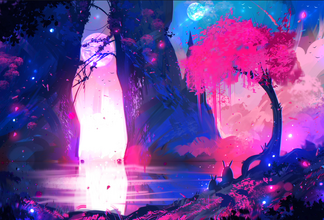
Even though it looks like heaven, don't be tricked; the sea is actually molten metals and colors are results of powerful fission
Of course, rocky planets are the most common home planets for life. Their atmosphere formation is active due to slow evaporation of radioactive metals. Atmosphere blown away by eruptions are quickly repaired with fresh metal gases. They are commonly found in Goldilocks zone, raising percentage of rocky home planet even more.
Rocky planets are usually home to gigantic plants and smol animals. It takes few billion years for primordial smol lifeforms to evolve to use tools (then it is technology progress party time!!! Oh yeah!!!). Natural selection is rare because of (relatively) very kalm environment supports almost any genes.
Unlike liquid planets, rocky planets' grounds are bound to tectonic plate of planet. It actually has tons of benefits to life on it. First, grounds are stable and does not flip. Second, open cracks of tectonic plate controls volcanic reactions, stopping from too much radioactive metal gas from accumulating and becoming gas planet.
And as it is wrote in picture description, even this kalm planet is evil. Don't try to go examine mystic creatures there, consequences will be always larger than you experienced.
⌬Liquid planet
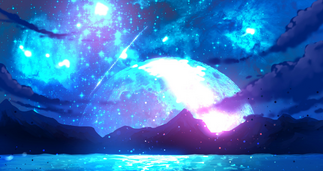
liquid planet with chonk moon... F to pay respect for corpses of lives...
Yup, I insulted instability of these type of planets so much, that it won't be necessary to insult more.
NO I HAVE CRAP TON MORE TO INSULT addition to deadly flipping islands, lives on this planet is basically doomed if something such as moon is orbiting the planet. It doesn't matter is moon is smol, but it really, SERIOUSLY matters for chonk moons.
The sea of this planet stretches all the way down to quarter radius of planet, keeping ocean's liquid form with immense heat. Not only this creates enormous explosions rupturing ocean and some unlucky islands, deep metal ocean makes islands vulnerable to submerging caused by insane height tidal wave of moon.
Only extremophiles and fishes live here, and liquid planet being home to land animals is very rare. Intelligent civilization mainly arise from fishes... Weird? Well, I don't care because I created this verse XD
⌬Gas planet

Huh!? Birbs living in gas planet?? How! >:0
Gas planets are little more extreme than liquid planets because gas planets are basically liquid planet with over-chonked atmosphere.
Molecules for life can be formed by upward winds rising from very bottom of atmosphere. Wind randomly mixes molecules until molecule finds stable and strong arrangement. Then molecules clump up together to form bacteria (and also f██king viruses similar to f██king cold currently making me sick for month) and smol cells.
Now it's cells' turn to arrange together to form animals, most of which are birbs. Those birbs evolve in countless different ways, and there are even birds look like fighter planes. There are no land animals because there are no land.... isnt it too obvious?
Well, there IS land appearing for a brief time. Fitful fission flash occasionally happening deep inside the planet lifts more than 1 earth mass worthy radioactive metal gas from deepest place of planet. The gas quickly solidifies and it stays in specific density region due to that solid being less than certain density region.
This allows birbs to rest on fragment. The fragment islands provide habitats for all birbs because smol island float higher in atmosphere and chonk islands float in low part of atmosphere. But islands eventually sink away to bottom because eruption wind from fission eruption weakens over time and islands reeeeee into their origin.
⌬Moons

kalm.....................................
Moon of another planet is also good home for life. Aside from moons of ring planets where the moon is showered by pea or house sized meteor, many moons satisfy major safety conditions for plutfuseverse life. Unlike moons of our universe with absolutely weak heat source, plutfuseverse moons are basically huge atomic bomb.
These atomic bombs with purity over 30% provide enough gamma rays to warm the moon even more than planets. So there can be liquid moons or solid moons, basically every type dwarf planet can be. it has radioactive metal sea and regions like those, allowing many types of lifeforms.
Some disbenefit tho, is tidal locking. Tidal locking is bad for life because it allows star wind to fling off atmosphere and liquids from the moon. But it does not matter much because many moons are boiling with heat and it replaces missing atmosphere, sometimes more than enough. It produces gas moon, home to birbs.
Just like planets, moons are hellish.
⌬Rogue planet

It doesn't seem like rogue planet, but it is; this rogue planet is passing next to active black hole :P
Oh yess this is final home planet type to cover!!!
Rogue planets form if the planet is flung out of its star or planetary system via reasons like chonk asteroid collision or loosing tug-o-war of attraction between other bodies. When that happens, planet either crashed into star or planet ir become rogue planet drifting through space alone (with some moons).
Rogue planets hardly have active heat source to support plutfuseverse lives. Their cores are usually near inactive due to cutoff of outer supply of plutonium. Without asteroids falling onto planet, being disassembled, and sustain planet's core fission, heat of rogue planet extinguishes.
However there can still be life on rogue planets. When rogue planet passes near gigantic black hole or star, it usually gives new orbit for rogue planet. However the orbit is super unstable and life has to emerge quickly before rogue planet gets flung off from system again and loose almost all heat.
(plants can freeze until rogue planet is warm tho)
⌬Civilization types
Few lifeforms can advance to level where they can control celestial bodies. They are classified by COS, which is not cosine but Celestial Object Scale. It is civilization classification scale defined by energy the civilization has complete control. Below are list of systems each types of civilization control:
COS 1 civilization controls planetary system with moons and sometimes binary planets.
COS 2 civilization controls stellar system with many planetary systems.
COS 3 civilization controls galaxy with countless star systems.
COS 4 civilization controls central void galaxy of first galaxy web hosting immense number of galaxies.
COS 5 civilization controls central void galaxy of second galaxy web which is collection of first galaxy web.
COS 6 civilization controls third galaxy web, which I didn't mention but is blurry upper structure of second galaxy web.
...
COS ω civilization controls whole plutfuseverse and its central galaxy.
COS Ω civilization controls everything inside outer imaginary globe, or influential area boundary of plutfuseverse.
⌬COS 0 ~ 1
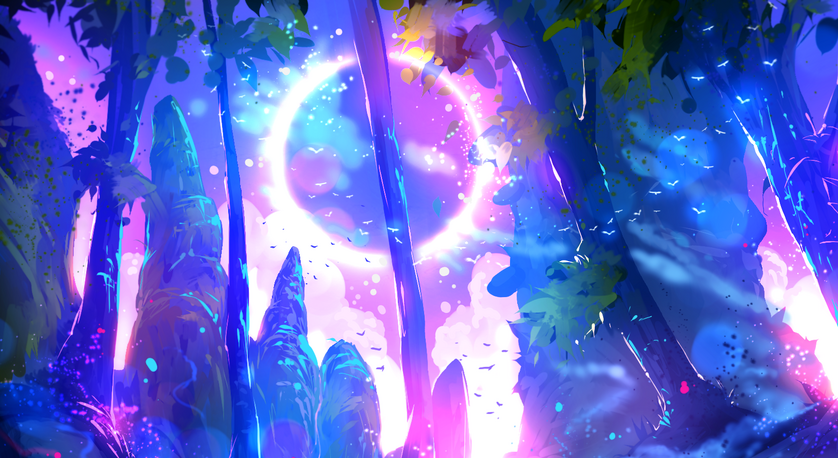
Ecosystem on planet around active black hole
These types occupy just one small river to area almost covering entire planetary system. Civilization at this scales are mostly very primordial ancestor of conscious beings, middle age, to something humanity will achieve near future.
Here, civilizations can co-exist or have control over its home planetary system's ecosystem.
- COS 0: Civilizations at this level are quite... boring because they only know how to manipulate
TREE(3)trees, smol rivers and maybe some little rocks. They didnt even discover a process that can help development of civilization like Zimbabwe dollar inflation: f i r e equivalence reaction of course. Not many things to explain, passing to next :P
- COS 0.1: Civilization is spread across one country worth of island or land mass. Ancient Egypt or Inca Empire is at COS 0.1 and has power to decrease entropy (level of disorder. Higher system is equal, for example your milk shake before you mix it violently with straw for absolutely no reason, has lower entropy and after you mix it the milk shake has high entropy bcuz its all mixed) of ecosystem by noticeable amount.
- COS 0.2: Ancient Cartago Empire is about at this level, where civilization is advanced enough to control quite a big amount of land area. Their technology is at level of huge castle, making some interesting and byotiful actions happen. These civilization (very) often engages in war with other civilizations around it, although I'm sure that they will go war with at least smarter reason than COS 0.2 civilization existed on earth few thousand years ago did.
- COS 0.3: Has sophisticated trading systems with other civilizations on its planet and uses more complex weapons like rock grenade and chained arrow
notationlauncher. Giant structures comparable to Forbidden City in china appears over the planet, and middle age style war happens constantly. Again, they will war with other civilizations for more proper, smarter reason.
- COS 0.4: Our smol civilization grew to WWII level civilization in no time :O! After some brutal colonization period like our grandgrandgrand...(not sure)...grand ma / pa experienced, civilizations now compete with each other violently, killing very much of their race. The war is never a good choice, and COS 0.4 civilization will (likely to) say that war is bad and peace is gud.
- COS 0.5: after few brutally unpleasant war, technology has progressed to our level where civilization is spread across the planet's surface. They now realize how bad they have done to their planet and cares. I mean, they TRY to care. Like us, there are always some scumbags above most low-social power ppl who gets moolah by some of dumbest reasons someone can imagine.
This can accumulate if problems are not solved soon, when planet is polluted so much. This effect leads to great filter where every single one of races die out due to immense pollution or cyberpunk style societies with indescribable amount of civilization potential being wasted. None is good, and grimly, civilizations that are lucky enough to not go through this phase is little rare at 20%.
- COS 0.53: This is where humanity is now.
- COS 0.6: Race expands greatly into space, attempting to build huge artificial habitats on planetary system's orbit. They also have science level where comparing to humanity is kinda meaningless. In addition to orbital structures, they also constructed smol colony on moons & planets that their home object is orbiting or orbits their home object.
- COS 0.7: Civilization now dominates satellite orbits of home planetary system. It is acting actively on colonization of home planetary system's objects. There is not really a progress humanity can compare to COS 0.7 civilization.
- COS 0.8: Many objects around this civilization's home system are completely colonized, and system satellite orbits are filled with gigantic artificial structures.
- COS 0.9: Civilization almost colonizes the system and starts building megastructures like ringworld from metals of planetary system.
- COS 1.0: Civilization colonized their entire home planet, and has power to manipulate orbits of planets, terraform, and can do all sort of things they want to planets of their home planetary system.
⌬COS 1~2
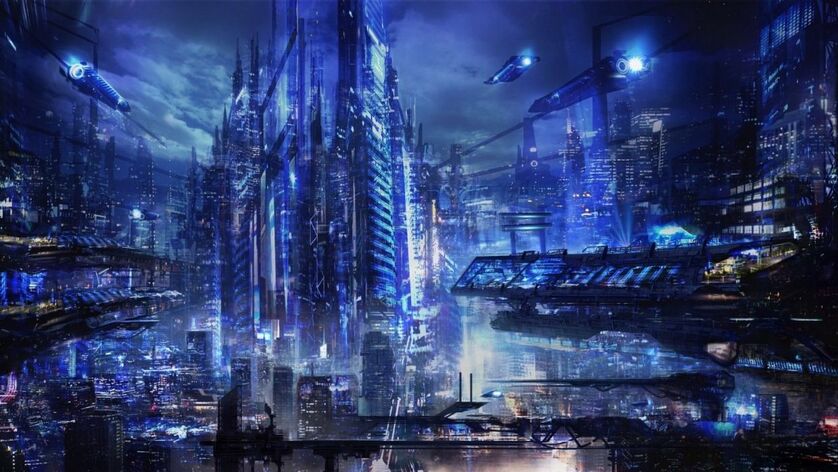
Civilization's main energy sources and building materials are radioactive metals and Cerenkov radiation from their decay. And picture is not capital or anything, it is just one smol city at most undeveloped region of type 1 civilization -3-
With supertechnologies in their hands, civilization begins to colonize planetary systems orbiting their host star (it could be binary, trinay, or beyond, so Im not sure whether I should attach "s" or not). There are LOTs of planetary systems or individual objects even around single star, so much to colonize!
- COS 1.2: Technology of COS 1.2 level is unpredictably advanced. Terraforming only takes few years (in case of VERY big planet) to few seconds (in case of dust particle size of ⓧ button on mobile ADs or asteroid size of one country). Terribly fast compared to humanity where currently terraforming technology can colonize somethin eternity later due to lack of terraforming technology itself.
Science and maths of this civilization perfectly explains every individual particles there is, and predicts every reactions of every celestial objects inside their perspective globe. They can theorize the plutfuseverse's size and mechanism, but still, they don't know if it is certain or some extremely smart boi malfunctioning every single computers of civilization.
- COS 1.4: Here, civilization is completely controlling two to six planetary system depending on size of planetary system. They mastered terraforming technology and has many megastructures orbiting host star. Technology has progressed at level where control of electromagnetic force at planetary scale is almost at perfection.
Subatomic particles and anti-matter is being produced in industrial scale, and physically stored (not including bytes in electronics) astronomical information about their perception on plutfuseverse is bigger than quintillions of times library of congress (the biggest library on earth, as for now). Only physically stored astronomical information is at this level, and now imagine how much information about memes and other stuffs will be at their grand library! :O
- COS 1.6: Due to basically unlimited ingredient, COS 1.6 civilizations start to build a Dyson ring capable of harvesting fraction of star's radiation. They also have control over all planets in their star system now, and is beginning to go other star systems either by spaceships or moving their star. Information generated by this level civilization is equivalent to Micro SD card pile bigger than whole solar system.
The biggest thing COS 1.6 civilizations do is that they are draining mass from their star to build structures. Mass draining technology is great enough for civilization to harvest few planet-worthy material every second. Sure, it is not that great progress compared to consumption of civilization, but star rippingoff (in other scientific word, it is called "star lifting") tech is at primitive level.
- COS 1.8: "...Omg they now have destructive that easily destroys whole planet in one sweep IDK what to do oh how bout I make politicians and riches go crazy again like they did in COS 0.5 type allright then lets do it that should work OwO that worked they are now nuking each other and civilization got back to primitive stage and every megastructures are damaged unrepairable UwU..."
Yeah... it is great filter again like COS 0.5 phase. Above is description about COS 1.8 great filter totally not a thing I made up for destruction and fun. Ah yes so Genetics of Greed never seem to go away. However if civilization kicks away great filter, they are likely to have a Dyson swarm (Swarm of Dyson rings) capable of harvesting few percents of host star's energy.
- COS 2.0: At here, race uses trans-light speed travel (I mean light speed of our universe) and information produced by COS 2 civilization transcendents our universe's data storage (I think data capacity of observable universe was something like 10356 bytes) (NaH searched for real and it was 2305 bytes or about 1090 bytes), meaning they have a way to store insane amount of information in insanely smol space.
Technology reaches level where Dyson sphere is possible but not building it because civilization don't want to freeze their planets. But they are close enough; they are likely to build very smort structure that emits necessary spectrum of star's light through the orbit plain of planet. Civilization also have technology to disassemble whole star for planet material but they are also not doing it because Dyson sphere is useless without star.
⌬COS 2~Maximum Finite
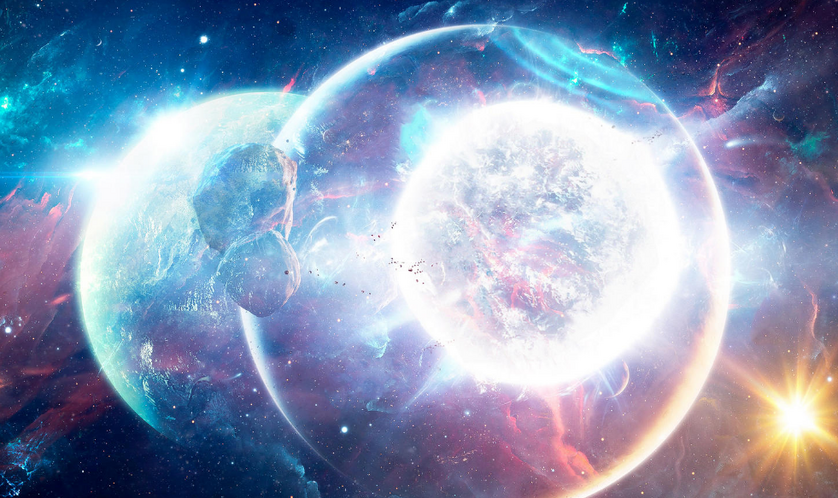
Example of miniverse created by COS 2.9 civilization. It can contain gigantic universal scale space in area smaller than a planet, but more on that in other pages :P
⌬COS ω
Plutfuseverse is theirs. Infinite civilization scale is quite nonsense but quantum tunneling can help achieving this scale in little shorter time (it is still infinite tho) because its speed is drilling hole through different quantum field = instant teleportation = speed ∞. Well............ it is really hard to distinguish from gods, so I will move onto nex scale again....
